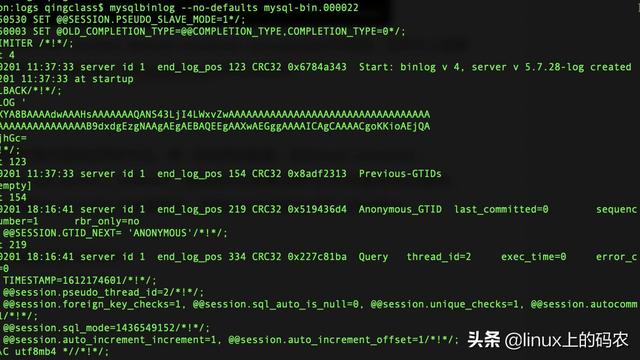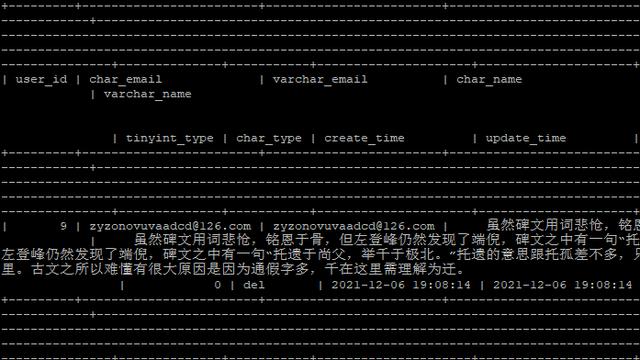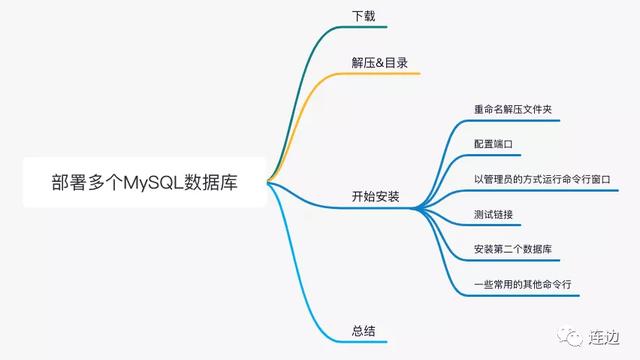概述
performance_schema提供监控策略及大量监控项,包括:元数据锁、进度跟踪、事务、内存使用及存储程序等。但是,performance_schema又过于复杂,操作不便,所以5.7新增了 sys schema,基础数据来自于 performance 跟 information_shcema两个库,本身数据库不存储及集采数据。
一、sys schema里面视图的分类
那么sys schema在查询中的功能,哪些可以查看数据库服务资源的使用情况?哪些主机对数据库服务器的访问量最大?实际上的内存使用情况?这就要了解里面的视图了。
1、主机相关信息
以host_summary开头的视图,主要汇总了IO延迟的信息,从主机、文件事件类型、语句类型等角度展示文件IO的信息;
2、innodb相关信息
以innodb开头的视图,汇总了innodb buffer page信息和事务等待innodb锁信息;
3、IO使用情况
以IO开头的视图,总结了IO使用者的信息,包括等待IO的情况、IO使用量情况,从各个角度分组展示;
4、内存相关信息
以memory开头的视图,从主机、线程、用户、事件角度展示内存使用情况;
5、连接与会话相关信息
其中,processlist 和 session相关的视图,总结了会话相关的信息;
6、表相关信息
以schema_table开头的视图,从全表扫描、innodb缓冲池等方面展示了表统计信息;
7、索引相关信息
其中包含index的视图,统计了索引使用的情况,以及重复索引和未使用的索引情况;
8、语句相关信息
以statement开头的视图,统计的规范化后的语句使用情况,包括错误数、警告数、执行全表扫描的、使用临时表、执行排序等信息;
9、用户相关信息
以user开头的视图,统计了用户使用的文件IO,执行的语句统计信息等;
10、等待事件相关信息
以wait开头的视图,从主机和事件角度展示等待类事件的延迟情况;
二、sys schema日常应用
1、查看process
1.1、常用的3个查询
有以下3个查询:
其中,show processlist为简要查看当前连接数据库情况,包含SQL语句的statement列仅提供部分SQL,而show full processlist则提供完整的SQL 语句,information_schema.processlist的内容与show full processlist 内容一致,但是可以以表格查询的形式添加where条件,达到自己的使用需求。
show processlist;
show full processlist;
select * from information_schema.processlist where state!='';
1.2、sys的四个视图
除此之外,sys提供以下四个视图查看 连接情况,这四个则更为详细的提供了 行数情况、临时表情况、当前SQL以及最后提交SQL(即使是sleep状态,这里也有最后提交的SQL可以查看)等信息。
若想详细查看,可以通过 `performance_schema`.`events_statements_current` 表格查看,通过sys.processlist 的thd_id关联查看。
select * from sys.processlist;
select * from sys.session;
select * from sys.x$processlist;
select * from sys.x$session;
2、查看表访问量
SELECT
table_schema,
table_name,
sum( io_read_requests + io_write_requests ) io
FROM
schema_table_statistics
GROUP BY
table_schema,
table_name
ORDER BY
io DESC
LIMIT 10;
3、冗余索引与未使用索引
--冗余索引查看
select table_schema,table_name,redundant_index_name,redundant_index_columns,dominant_index_name,dominant_index_columns from sys.schema_redundant_indexes;
--未使用索引查看
select * from sys.schema_unused_indexes;
4、表自增ID监控
select * from sys.schema_auto_increment_columns;
5、监控全表扫描的sql语句
select * from sys.statements_with_full_table_scans where db = 'pas_prod' order by exec_count desc;
6、查看实际消耗磁盘IO的文件
select file,avg_read+avg_write as avg_io from io_global_by_file_by_bytes order by avg_io desc limit 10;
三、sys schema视图一览表
sys schema只有一张表sys_config,一般关注statement_truncate_len列就行(影响函数format_statement()截断SQL后的长度,即最后SQL语句显示的总长度,默认为64),最重要的就是里面的视图了。
sys库的视图分为 带x$跟不带x$前缀的视图,这两种没啥实质性区别,不带 x$ 的视图是人性化的结果展示,会有一些单位换算,而带x$前缀的则是原始数据单位,未经换算。
1、主机相关
以host_summary开头的视图,提供IO延迟等相关信息
1.1、视图一览
- The host_summary and x$host_summary Views
- The host_summary_by_file_io and x$host_summary_by_file_io Views
- The host_summary_by_file_io_type and x$host_summary_by_file_io_type Views
- The host_summary_by_stages and x$host_summary_by_stages Views
- The host_summary_by_statement_latency and x$host_summary_by_statement_latency Views
- The host_summary_by_statement_type and x$host_summary_by_statement_type Views
1.2、应用场景
1.2.1、host_summary(常用)
日常中主要使用的是host_summary视图,可以根据连接数据库的host总的执行sql数目、执行时长、表扫描、文件IO、连接情况、用户情况及内存分布情况,可以让DBA快速定位到是哪台host最耗费数据库资源,对连接数据库的所有host有一个大致的资源使用情况的了解。
select * from sys.host_summary;
1.2.2、host_summary_by_file_io_type
详细查看每个host的主要是在什么文件类型上耗费IO资源,可以查看 host_summary_by_file_io_type视图

1.2.3、host_summary_by_file_io
仅查看每台host总的IO情况,则可以查看视图host_summary_by_file_io
select * from sys.host_summary_by_file_io;
2、innodb相关
以innodb开头的视图,汇总了innodb buffer page信息和事务等待innodb锁信息
2.1、视图一览
- The innodb_buffer_stats_by_schema and x$innodb_buffer_stats_by_schema Views
- The innodb_buffer_stats_by_table and x$innodb_buffer_stats_by_table Views
- The innodb_lock_waits and x$innodb_lock_waits Views
2.2、应用场景
2.2.1、 innodb_buffer_stats_by_schema
当一个实例中有多个业务库,由于性能问题,可能想查看下各个数据库的内存占用情况,可以使用视图 innodb_buffer_stats_by_schema,但是少用慎用,因为会扫描整个buffer pool来统计,如果所在实例buffer pool非常大,那么这是一个极为耗费资源的查询,建议慎用。这个视图实际上是通过 视图 innodb_buffer_stats_by_table的数据做了group by object_schema得到的。
select * from sys.innodb_buffer_stats_by_schema;
2.2.2、 innodb_buffer_stats_by_table(常用,慎用)
在某种情况下,需要查询表格在内存中的占用情况,可以通过视图 innodb_buffer_stats_by_table来查询,也是扫描整个buffer pool统计,少用慎用。
select * from sys.innodb_buffer_stats_by_table;
3、IO相关
以IO开头的视图,等待IO情况/IO使用情况
3.1、视图一览
- The io_by_thread_by_latency and x$io_by_thread_by_latency Views
- 各个IO线程的使用情况
- The io_global_by_file_by_bytes and x$io_global_by_file_by_bytes Views
- 各个数据库文件的IO情况
- The io_global_by_file_by_latency and x$io_global_by_file_by_latency Views
- 各个数据库文件的IO耗时情况
- The io_global_by_wait_by_bytes and x$io_global_by_wait_by_bytes Views
- 数据库事件IO等待情况
- The io_global_by_wait_by_latency and x$io_global_by_wait_by_latency Views
- 数据库事件IO等待耗时情况
- The latest_file_io and x$latest_file_io Views
- 当前正在读写文件的情况
3.2、应用场景
3.2.1、io_global_by_file_by_bytes(常用)
查看数据库实例的IO分布情况,及着重优化对象,可以使用 io_global_by_file_by_bytes
select * from sys.io_global_by_file_by_bytes order by count_read desc;
4、内存相关
以memory开头的视图,从主机/线程/用户等角度展示内存的使用情况
4.1、视图一览
- The memory_by_host_by_current_bytes and x$memory_by_host_by_current_bytes Views
- The memory_by_thread_by_current_bytes and x$memory_by_thread_by_current_bytes Views
- The memory_by_user_by_current_bytes and x$memory_by_user_by_current_bytes Views
- The memory_global_by_current_bytes and x$memory_global_by_current_bytes Views
- The memory_global_total and x$memory_global_total Views
4.2、应用场景
4.2.1、memory_by_host_by_current_bytes、memory_by_thread_by_current_bytes 、memory_by_user_by_current_bytes
当前内存使用情况,从 host、thread、user等角度来分别查看,对应各自的视图即可。
select * from sys.memory_by_host_by_current_bytes;
5、连接与会话相关
含有processlist和session的视图,显示会话相关的信息
5.1、视图一览
- The processlist and x$processlist Views
- The session and x$session Views
- The session_ssl_status View
5.2、应用场景
5.2.1、processlist(常用)
查看连接使用情况,session的结果跟processlist类似。查看连接情况,有非常多种方式,每种方式都有各自的使用情况。
select * from sys.processlist;
6、表相关
以schema_table开头的视图,从全表扫描/innodb缓冲池表现表统计信息
6.1、视图一览
- The schema_table_lock_waits and x$schema_table_lock_waits Views
- The schema_table_statistics and x$schema_table_statistics Views
- The schema_table_statistics_with_buffer and x$schema_table_statistics_with_buffer Views
- The schema_tables_with_full_table_scans and x$schema_tables_with_full_table_scans Views
- The schema_auto_increment_columns View
6.2、应用场景
6.2.1、schema_table_statistics(常用)
查看表格的update、delete、insert、select的IO情况,可以使用schema_table_statistics视图
select * from sys.schema_table_statistics;
6.2.2、schema_tables_with_full_table_scans(常用)
查看表格的全表扫描情况,抓取需要重点优化的对象,可以使用视图schema_tables_with_full_table_scans
select * from sys.schema_tables_with_full_table_scans;
6.2.3、schema_auto_increment_columns(常用)
查看表格的自增长是否快达到瓶颈了,有些表格存在频繁的删除操作,可能导致自增ID的最大值跟表格数量极不相符合,为了避免问题,可以通过视图 schema_auto_increment_columns,查看有哪些表格快要达到自增的瓶颈值
select * from sys.schema_auto_increment_columns order by auto_increment_ratio desc;
7、索引相关
含有index的视图
7.1、视图一览
- The schema_object_overview View
- The schema_redundant_indexes and x$schema_flattened_keys Views
- The schema_unused_indexes View
- The schema_index_statistics and x$schema_index_statistics Views
7.2、应用场景
7.2.1、schema_object_overview(常用)
查看当前实例内各个数据的对象及索引分布情况,可以使用 schema_object_overview
select * from sys.schema_object_overview where db='pas_prod';
7.2.2、schema_redundant_indexes(常用)
查看数据库的冗余索引情况,可以通过视图 schema_redundant_indexes,但不是所有冗余索引都要删除,需要衡量实际的使用情况、索引大小、索引扫描情况后再决定。
select * from sys.schema_redundant_indexes;
7.2.3、schema_unused_indexes(常用)
查看数据库没有使用的索引,可以使用 schema_unused_indexes
select * from sys.schema_unused_indexes;
7.2.4、schema_index_statistics(常用)
查看索引的select \updatedeleteinsert情况,可以使用schema_index_statistics
select * from sys.schema_index_statistics;
8、语句相关
以statement开头的视图,显示错误数、警告数、执行全表扫描、使用临时表、执行排序等信息
8.1、视图一览
- The statement_analysis and x$statement_analysis Views(常用)
- The statements_with_errors_or_warnings and x$statements_with_errors_or_warnings Views(常用)
- The statements_with_full_table_scans and x$statements_with_full_table_scans Views(常用)
- The statements_with_runtimes_in_95th_percentile and x$statements_with_runtimes_in_95th_percentile Views
- The statements_with_sorting and x$statements_with_sorting Views(常用)
- The statements_with_temp_tables and x$statements_with_temp_tables Views(常用)
8.2、应用场景
汇总SQL中错误数、警告数、执行全表扫描、使用临时表、执行排序等信息,sql语句也是使用 format_statement() 函数做了长度限制,如果想查看完整的SQL,可以通过 这个表格的这一列查看performance_schema`.`events_statements_summary_by_digest`.`DIGEST_TEXT`,关联的添加列是 DIGEST
9、用户相关
以user开头的视图,显示用户使用的文件IO/执行语句的统计信息
9.1、视图一览
- The user_summary and x$user_summary Views (常用)
- The user_summary_by_file_io and x$user_summary_by_file_io Views
- The user_summary_by_file_io_type and x$user_summary_by_file_io_type Views
- The user_summary_by_stages and x$user_summary_by_stages Views
- The user_summary_by_statement_latency and x$user_summary_by_statement_latency Views
- The user_summary_by_statement_type and x$user_summary_by_statement_type Views
9.2、应用场景
从用户的角度,分别统计文件的IO情况、sql执行情况,如果数据库的用户是按照业务模块来划分的,那么则可以清晰的看到哪些业务耗费资源较多
10、等待信息
以wait开头的视图
10.1、视图一览
- The wait_classes_global_by_avg_latency and x$wait_classes_global_by_avg_latency Views
- 按事件event分组,统计各个event的平均延迟时长
- The wait_classes_global_by_latency and x$wait_classes_global_by_latency Views
- 按事件event分组,统计各个event的总延迟时长
- The waits_by_host_by_latency and x$waits_by_host_by_latency Views
- The waits_by_user_by_latency and x$waits_by_user_by_latency Views
- The waits_global_by_latency and x$waits_global_by_latency Views
- 所有event的延迟情况
10.2、应用场景
等待类视图,分别从事件、主机、用户等角度,进行查询分析。
sys schema上的视图对于做性能分析是很重要的,建议大家重点掌握~
后面会分享更多devops和DBA方面内容,感兴趣的朋友可以关注下!






















